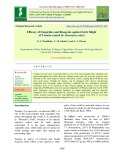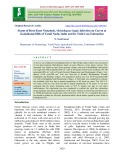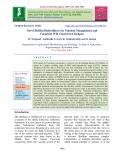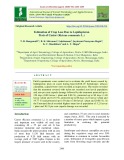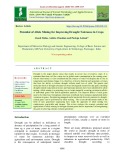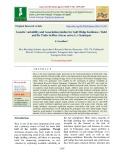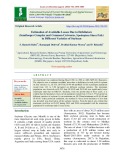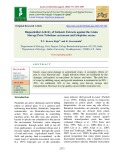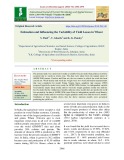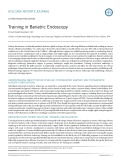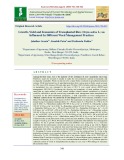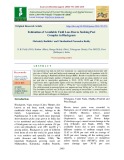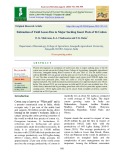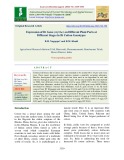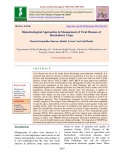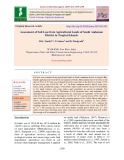
Estimation of yield losses
-
The yield losses in the range of 48-80 per cent due to early blight (Alternaria solani) damage in tomato were reported from India, Canada, USA and Nigeria (Basu, 1974; Datar and Mayee, 1984; Mathur and Shekhawat, 1986; Sherf and MacNab, 1986; Gwary and Nahunnarao, 1998 and Pandey and Pandey, 2002). The annual economic yield losses due to early blight have been estimated at 79% (Adhikari and Panthee, 2017).
 8p
8p  chauchaungayxua11
chauchaungayxua11
 23-03-2021
23-03-2021
 14
14
 2
2
 Download
Download
-
This study was aimed at quantifying yield loss due to high temperature induced damages on head rice recovery in rice. Fifteen rice varieties were evaluated over 3 seasons and their head rice recovery was estimated. Results of this study revealed that day temperature had no influence on the head rice recovery whereas night temperature had negative impact on head rice recovery at p < 0.05.
 6p
6p  trinhthamhodang1218
trinhthamhodang1218
 26-02-2021
26-02-2021
 9
9
 1
1
 Download
Download
-
A survey was conducted in Kodaikanal hills of Tamil Nadu, India to know the association of root-knot nemtode, Meloidogyne hapla in carrot (Daucus carota subsp. sativus). The nematode was found in eight carrot growing villages surveyed at Kodaikanal. Infestation was high (150-300 nematodes/200 cm3 soil) at Poomparai followed by moderate (50-150 nematodes/200 cm3 soil) at Poondi, Kookal, Mannavanur and Shenbananur villages.
 7p
7p  caygaocaolon8
caygaocaolon8
 07-11-2020
07-11-2020
 13
13
 2
2
 Download
Download
-
Study on management of groundnut root grub Holotrichia fissa Brenske was carried out at Hattarwata village of Chikkodi (Belagavi district) during 2014-15 in kharif season. The yield loss also increased with the increase in grub density both in untreated and seed treated conditions under field conditions.
 10p
10p  chauchaungayxua8
chauchaungayxua8
 03-10-2020
03-10-2020
 5
5
 1
1
 Download
Download
-
Wilt caused by Fusarium oxysporium f. spciceris is a devastating disease of chickpea. It occurs in 2 stages; seedling stage (0-30%) and reproductive stage (0-57%). Annual chickpea yield loss due to Fusarium wilt was estimated to be 10% in India. So, our objective is to control chickpea wilt disease by using Trichoderma based biofilms as an alternative to chemical fungicides. Trichoderma viride is a potential antagonistic fungi which prevents diseases like wilt, brown rot, damping off, charcoal rot etc.
 7p
7p  trinhthamhodang1215
trinhthamhodang1215
 23-09-2020
23-09-2020
 18
18
 2
2
 Download
Download
-
The present study was undertaken with the main objective of generating data on the yield losses caused by lepidopteran pests in castor...
 5p
5p  nguaconbaynhay7
nguaconbaynhay7
 15-08-2020
15-08-2020
 18
18
 1
1
 Download
Download
-
Drought is the major abiotic stress that results in severe loss of yield to crops. It is estimated that there will be a steep rise in global water consumption in the coming years. On the other hand, it is also estimated that the sources of water will deplete due to rise in temperature and climate change. It is, therefore, critical to find out such genotypes of crops that have the ability to tolerate drought without much loss of yield.
 20p
20p  caygaocaolon6
caygaocaolon6
 30-07-2020
30-07-2020
 5
5
 1
1
 Download
Download
-
Rice is the most important staple food crop in the world particularly in South East Asia and gets infested with gall midge which is an important pest especially during rainy season with delayed sowings resulting in huge losses to the farmers in Northern Telangana Zone, India. Forty five genotypes were studied for the estimation of genetic variability at Agricultural Research Station, Kunaram, Telangana.
 9p
9p  angicungduoc5
angicungduoc5
 12-06-2020
12-06-2020
 21
21
 1
1
 Download
Download
-
An experiment was conducted during Kharif 2014 to 2016 at ARS, MPUAT, Banswara. The objective was to estimate avoidable losses due to defoliators in seed yield of soybean on four varieties viz., JS-335, JS-93-05, JS-95-60 and RKS-24.The semilooper population varied from 1.21 to 3.96 larvae/mrl on different soybean varieties.
 8p
8p  caygaocaolon5
caygaocaolon5
 27-05-2020
27-05-2020
 10
10
 1
1
 Download
Download
-
Insects cause great damage to agricultural crops. A secondary effects of pest is viral, bacterial and fungal infection where are facilitated by the damages and injured to crop plants by insects and mites. The yield loss of crops by nibbling, injury and growth retardation is estimated to be 20% - 30%. An additional 10% is lost during post harvest storage and transportation. Decrease in crop quality causes further economic loss.
 15p
15p  trinhthamhodang5
trinhthamhodang5
 16-05-2020
16-05-2020
 8
8
 1
1
 Download
Download
-
The present study was carried out to make a suitable forecast model that predicts yield loss occurred due to weeds in wheat crop. The data were taken from the annual report of AICRP-WM centres. Gwalior and Pusa are the two centres in which the work has been carried out. Weed density and weed dry weight were two weed infestation measurements that were considered for model fitting.
 5p
5p  chauchaungayxua5
chauchaungayxua5
 08-05-2020
08-05-2020
 11
11
 1
1
 Download
Download
-
Obesity has become a worldwide pandemic that has tripled in the past 40 years, affecting children and adults and resulting in various obesity-related comorbidities.1 In a CDC report from 2016, the prevalence of adult obesity was near 40% with an estimated annual medical cost in the United States of $147 billion.2 Although bariatric surgery has yielded promising results in combatting obesity, acute and chronic complications such as surgical leaks and weight regain are not uncommonly encountered.
 3p
3p  covid19
covid19
 11-05-2020
11-05-2020
 32
32
 2
2
 Download
Download
-
Among the food crops, rice is the mainstay of the sustenance of Asia’s population since long. Therefore, smart rice research is needed to make the rice production systems economically and ecologically sustainable. Weeds are known to be a major biotic constraint in agricultural production systems. Of the total annual loss of agricultural produce from various pests in India, weeds accounts for 45%, insect 30%, diseases 20% and other pests 5% (Rao, 1983). In India, yield loss due to weeds in transplanted rice was estimated to the tune of 30.
 15p
15p  chauchaungayxua5
chauchaungayxua5
 05-05-2020
05-05-2020
 7
7
 1
1
 Download
Download
-
An experiment was laid out with two treatments viz., unprotected and protected plot with plot size of 100 m2 each and further each treatment was divided into 13 quadrates with 30 X 10 cm spacing in Randomised Block Design (RBD). Results revealed that the avoidable reduction in plant height, number of branches per plant, pods per plant, number of seeds per pod due to insecticides application is 19.14, 19.78, 20.70 and 17.80 per cent respectively and a significantly higher yield was obtained in protected plots i.e. 1028 kg ha-1 , while, comparatively low yield i.e.
 8p
8p  angicungduoc4
angicungduoc4
 26-04-2020
26-04-2020
 12
12
 1
1
 Download
Download
-
Present investigation on estimation of yield losses due to major sucking pests of the Bt cotton was carried out on the College Farm, College of Agriculture, Junagadh Agricultural University, Junagadh during Kharif season of the year 2011-12. The Bt hybrid cotton cultivar KDCHH-441 was grown with the plot size of 24 m X 20 m at spacing of 120 cm x 45 cm. The data revealed that significantly higher seed cotton yield 2038.82 kg/ha was recorded from protected plots, while the yield of 1312.70 kg/ha was recorded from unprotected plots.
 4p
4p  angicungduoc4
angicungduoc4
 26-04-2020
26-04-2020
 7
7
 0
0
 Download
Download
-
Cotton yield losses due to insect pests are estimated to be around 10 to 14 per cent every year. These insect protected cotton varieties contain a naturally occurring substance, Bacillus thuringiensis (Bt) protein which has been used as an ingredient in safe and effective biological sprays for more than 50 years.
 15p
15p  cothumenhmong4
cothumenhmong4
 23-03-2020
23-03-2020
 11
11
 1
1
 Download
Download
-
Chickpea is a cool season pulse and suffers severe yield losses when exposed to higher temperatures during reproductive phase. Stable chickpea production will depend on the release of new cultivars with improved adaptation to drought and high temperature. Twenty five breeding lines of two crosses JG 11 x JG 14 and JAKI 9218 x JG 14 were assessed under timely and late sown situations. High variability was observed for majority of the traits in both the seasons.
 8p
8p  cothumenhmong3
cothumenhmong3
 22-02-2020
22-02-2020
 18
18
 0
0
 Download
Download
-
Viral diseases are one of the major factors threatening crop production worldwide. It is estimated that about 15 percent of global crop production is lost due to various plant diseases, and phytopathogenic viruses are thought to cause more than one third of plant diseases. Viruses such as TYLCV, PRSV, CMV, BBTV are some major virus epidemics which cause heavy losses in horticultural crops. Management of plant virus diseases have acquired great importance in the realm of Plant Pathology and call for effective management against them.
 14p
14p  chauchaungayxua3
chauchaungayxua3
 07-02-2020
07-02-2020
 11
11
 0
0
 Download
Download
-
Soil loss was estimated from agricultural lands of South Andaman district in tropical Bay Islands applying Universal Soil Loss Equation (USLE). Mean annual rate of soil loss to the tune of 184.1 X 103 tons was estimated from the crop fields of the district covering 1747.0 ha area at the rate of 105.38 t ha-1 yr-1 . In South Andaman district, kharif crops (rice, maize, arhar, ground nut, ginger, sweet potato, tapioca and turmeric) are grown in medium to low lands whereas rabi crops (pulses and vegetables) are grown in uplands. The cropping intensity is 104.0%. Maximum (136.
 9p
9p  kethamoi2
kethamoi2
 14-12-2019
14-12-2019
 21
21
 1
1
 Download
Download
-
The present investigation highlights the feasibility of a polymer grafting process to enhance the durability and flame retardancy of rice straw towards application as a low cost roofing material. The success of this grafting methodology was perceived to depend upon a bi-step pre-treatment process encompassing delignification and inorganic salts dispersion. Subsequently free radical polymer grafting of acrylonitrile onto rice straw was implemented by immersion mechanism initiated by oxalic acid-potassium permanganate initiator.
 11p
11p  kequaidan1
kequaidan1
 16-11-2019
16-11-2019
 19
19
 0
0
 Download
Download
CHỦ ĐỀ BẠN MUỐN TÌM









